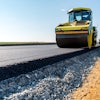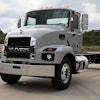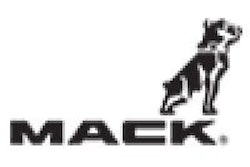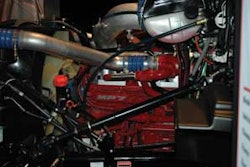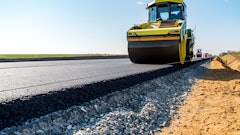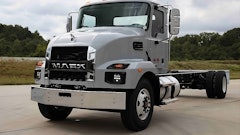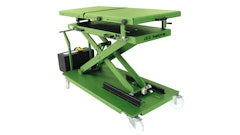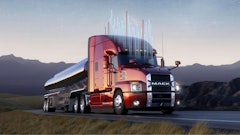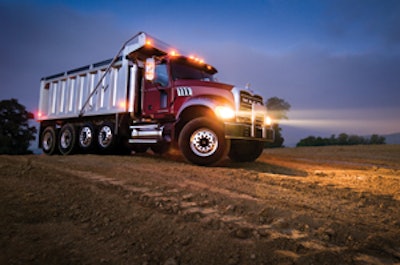
Recent fluctuations in diesel fuel pricing, and the new technologies being introduced to the diesel engine market, place increased emphasis on spec'ing the most efficient powertrain for your medium- and heavy-duty truck applications.
"Obviously, with the price of diesel fluctuating over the past year, we probably see a little more emphasis on getting the right engine, horsepower wise," says David McKenna, Mack Trucks powertrain marketing manager.
Efficiency is achieved by finding the best powerplant that matches your requirements. "First and foremost, never buy more horsepower or torque than you need," says McKenna.
Recently, however, more trucks have been spec'd with additional power. This can be attributed in part to competition for drivers. "With the driver shortage, there has been a horsepower creep," McKenna notes.
"Driver retention is always a big issue," says Matt Stevenson, manager of product strategy, Sterling Truck Corp. "A lot of times, guys like engines that are probably more powerful than they need. Drivers always like a little more power."
This can become a balancing act. "Giving the driver too much power, then taking the dump truck into deep mud or loose soil, does create its own problems in terms of tearing up driveline components or rear ends," says Stevenson.
Similarly, an under-sized engine creates productivity issues. "The last thing you want to do is get an engine that is under powered [in order] to get a lower weight," says Stevenson. "Then you just have poor driver impression of the vehicle. Maybe it is slow to get up hills, slow to start and then slow on the return trips."
Assess horsepower and torque needs
It's important to truly understand your power requirements. "If 325 hp and 1,300 or 1,400 lb.-ft. of torque will do it, don't go out and buy 425 hp with 1,660 lb.-ft. of torque. If you can match your engine, transmission and rear axle ratios, you can optimize that truck for a particular duty cycle," says McKenna.
This requires an understanding of the relationship between torque and horsepower. "Basically, torque is the ability to perform work," says McKenna. "Horsepower is the rate of speed [at which] you can do that amount of work."
Torque ratings too often take a back seat to horsepower ratings. "Most of the customers, unfortunately, still talk horsepower," says Stevenson. But torque is what actually gets the load moving. "In any application, it is best to figure out what your torque needs are, and then cruise speed to determine your horsepower needs."
The transmission choice will have a major impact on horsepower and torque requirements. "On the vocational side, we have certainly seen a growth in the powershift automated-type transmission," says McKenna. "The skill set of a lot of drivers today doesn't lend itself well to a fully manual transmission."
But there are trade-offs. "The fuel economy tends to suffer a little bit with the fully automated transmission," says McKenna. "The reason they call it a powershift is you don't have to lift your foot off the throttle for it to power up through the gears. The powershift manufacturer claims some productivity improvement, where you can get from Point A to Point B significantly faster."
And not all applications are candidates for automatic transmissions. "The automatics, for the most part, only go up to 1,650 ft.-lbs. of torque," says Stevenson. "With a large engine that has 1,850 lb.-ft. of torque, usually you can't get an automatic on a general construction rating."
However, the increased shifting precision may allow you to make more efficient use of the available torque and horsepower. "With an automatic transmission, you can usually use a smaller displacement and have it geared just right," says Stevenson. You can back off the horsepower rating a little bit because it is shifting more accurately than the average driver would. "There are fleets that will downsize to a 370-hp engine and run Allison automatic transmissions because they get as good a performance, better fuel economy and less wear and tear on the components."
Big block vs. small block
There are two different approaches to spec'ing the correct engine displacement. The correct choice depends on your business approach.
The main advantage to a small-block engine is the weight savings, which can be significant. For instance, the difference between a 12- or 13-liter and a 14- or 15-liter engine is at least 500 lbs. That translates to additional payload.
"For most dump truck applications, a 12- or 13-liter is plenty of engine," says Stevenson. "You can even go down to a lower displacement engine, like a 9-liter, to pick up more weight savings." This really depends on the load capacity day in and day out, and grades typically encountered in your operations.
Stevenson claims the 12- to 13-liter and larger 14- or 15-liter engines offer similar durability. "It is when you go down to the 9- or 10-liter engines that you start to get definite trade-offs on longevity," he states.
Recently, there has been an increase in power density that allows the use of smaller engines. "In the past few years, the horsepower and torque increases out of a medium bore, like a 12- or 13-liter engine, have gotten a lot higher," says Stevenson. "Now, they will go to 1,650 lb.-ft. of torque — some of them to 1,750 lb.-ft. — and horsepower above 430."
However, big-block engines still lead the way in terms of durability. For instance, in a given application, a smaller block engine may operate for two or three years before it requires a certain amount of work, according to McKenna. The mid-block may run eight to 12 years before requiring similar work.
Don't rely on history
You really need to work with a dealer to optimize the truck for your application. Some customers place too much emphasis on past history.
"They say, 'I want this horsepower and I know I need a .430 ratio,' " says Stevenson. "Well, the engines have changed a lot over the years. A lot of times, the deeper reduction ratios are not needed because the engines have to run a little faster for fuel economy; or they have more power down low than they used to; or the transmission gearing may have changed. So he should really consult with his dealer on the best way to spec for the given year that he is purchasing."
Mack provides the example of its latest MP Series engines. "We have managed to keep the horsepower levels in the offerings about the same, but we have managed to add anywhere between 200 and 400 lb.-ft. of additional torque," says McKenna.
This makes up for torque losses that occurred in the 2002-'04 product. During this time, many customers transitioned to larger engines to get the torque. "We now have transitioned them back into a very fuel-efficient, 'right-size horsepower/right-size torque value' engine."
Pay attention to the horsepower and torque curves of the particular engines you are considering, and make sure they best match the transmission and gearing for your application.
GVW drives medium-duty
Unlike heavy-duty trucks where you spec based on the appropriate engine size, medium-duty trucks are spec'd based on the appropriate GVW size. "The key here is to understand what GVW you need and build the truck to the proper GVW," says Todd Bloom, vice president - marketing, General Motors Isuzu Commercial Truck.
"We urge people to spec a truck to the right application and not just get a truck that happens to be sitting on the lot," he adds.
The differences between classes of trucks include the base price of the chassis, fuel economy and operating costs. With the new emissions equipment to meet '07 standards, the difference in ownership costs between different truck classes will be even more pronounced.
"The larger the vehicle, the larger the DPF (diesel particulate filter) is going to be," says Bloom. "You are going to see dramatic differences in price between classes of vehicles, based on the engines, because of the price of the emissions equipment that has to be hung on these vehicles."
This makes it more important than ever to consider the size of truck that you choose. "The proper GVW may mean that you select a truck based on 80% of its usage, not 100%," says Bloom. "The right vehicle may not be for taking care of every single need that you have." Rental may more cost effectively address the remaining 20%.


